How to Clean Engineered Hardwood Floors
March 26, 2024 | By Bruce Product Expert
That means giving your floors some love with regular cleanings and maintenance. But what’s the best way to go about that? We’ll give you some insights on how to keep your floors looking great. We’ll also answer some of the most common questions about floor care.
But before we address how to care for engineered hardwoods, let’s refresh you on what makes them unique.
Why Use Engineered Hardwood Flooring?
Engineered hardwood floors have become increasingly popular with homeowners. And why not? You get the same great looks of solid hardwood flooring but with an added advantage. Engineered wood floors have better water resistance than solid wood flooring.
That’s because their core consists of compressed plywood. That core adds stability to each plank, making it more stable. So, unlike solid hardwoods, engineered floors don’t expand and contract as much when exposed to moisture.
That allows you to use them more confidently in basements, kitchens, and laundry rooms. It also improves performance in high-humidity locations like Alabama, Florida, Georgia, and North Carolina.
The hardwood veneer provides a genuine wood floor, whether oak, hickory, maple, or walnut. Typically, an aluminum oxide finish protects that wear layer. So you gain added durability to handle heavy foot traffic..
Caring for Engineered Hardwoods
Caring for engineered hardwoods is similar to caring for solid hardwoods. However, you have a little more flexibility. For example, you can use a damp mop more readily than on a solid wood floor.
Otherwise, you follow the same regimen when caring for engineered floors. That regimen looks something like this.
Sweep and Vacuum Your Floors Routinely
One simplest yet most effective way to keep your engineered hardwood floors clean is to sweep or vacuum them regularly. Use a soft-bristle broom or a vacuum cleaner with a hardwood floor attachment to remove dust, dirt, and debris. This prevents small particles from scratching the surface.
Use a Microfiber Mop to Remove Debris
Invest in a microfiber mop for daily or weekly cleaning. Microfiber mops are gentle on the floor’s finish. More importantly, they have better cleaning power and more effective germ removal than a damp mop.
You can dampen the mop slightly. But avoid excessive moisture that could create water damage on your floors.
Selecting the Right Cleaning Products
Opt for a pH-balanced, hardwood-specific cleaner. You can use a homemade cleaner by mixing a few drops of mild dish soap with warm water.
Otherwise, you can select from ready-made cleansers like Bruce® Hardwood & Laminate Cleaner. It cleans and protects engineered hardwood floors without leaving residue.
You can dampen a microfiber mop with your cleaner for more stubborn stains and spills. Then, gently clean the area. But always remember, less is more. So avoid saturating the floor to prevent standing water.
Protecting Your Engineered Hardwood Floors
Regular cleaning keeps your floors in top-notch shape. It also avoids the buildup of dirt and debris that can scratch your floors. But you can protect your floors even more with some simple additions.
Place area rugs or mats at entrances and high-traffic areas. They’ll prevent the tracking of dirt and moisture onto the floors.
Attach felt or rubber pads to the legs of your furniture to prevent scratches and dents when moving chairs and tables.
Be careful with your footwear. Shoes with deep treads can easily pick up small stones that can scratch your floor. High heels, especially softer woods like pine and cherry, can dent or scratch your flooring..
What to Avoid When Cleaning Engineered Wood
First, remember that engineered hardwoods are water resistant, not waterproof. So avoid soaking your wet mop. Ensure you wipe up spills when they occur to prevent them from soaking into the wood.
Second, stay away from harsh chemicals, like ammonia-based cleaners. And despite what you might hear, vinegar-based solutions aren’t suitable for wood flooring. They can dull and even strip the finish.
Finally, don’t use wax and oil soaps. They can leave a sticky residue that dulls the top layer of your flooring.
Questions About Cleaning Engineered Hardwood Flooring
Here are some of the most common questions about cleaning engineered hardwoods. If you have other questions, we’d love to hear from you. Just call 1.866.243.2726.
What is the best thing to clean engineered hardwood floors with?
The best thing to clean engineered hardwood floors is a microfiber mop or a soft-bristle broom. These tools are gentle on the surface. They effectively remove dust and dirt without scratching.
What should you avoid when cleaning engineered hardwood?
Avoid using excessive water or harsh chemicals. Additionally, avoid abrasive scrub brushes and abrasive cleaners that can damage the finish.
Can you steam-clean engineered hardwood floors?
Steaming cleaning engineered hardwood floors is not advisable. Steam can introduce excess moisture into the wood. That can cause warping and damage. Stick to dry or damp cleaning methods to protect your floors.
Can you use Swiffer® wet pads on engineered hardwood?
You can use Swiffer® wet pads on engineered hardwood. They can clean most flooring surfaces.
Can you use Bona® on engineered hardwood?
Bona® is a popular and safe choice for cleaning engineered hardwood floors. Bona makes specific products designed for hardwood, which are pH-balanced and gentle on the finish.
Is Murphy’s Oil Soap® suitable for engineered hardwoods?
No. Murphy’s Oil Soap® isn’t suitable for engineered floors, despite what you might think. It can leave a residue that leaves floors looking greasy. It also can discolor and dull the shine.
What are some good homemade cleaners for engineered wood floors?
You make a homemade cleaner by mixing a few drops of mild dish soap with warm water. Use this solution sparingly, and make sure the mop or cloth is only damp, not wet. For tough stains, you can use vinegar and water (diluted in a 1:10 ratio). But, as mentioned, avoid using vinegar too frequently as it can be acidic and potentially damage the finish.
How do you make engineered hardwood floors look new again?
To make engineered hardwood floors look new again, follow these steps:
• Regularly sweep or vacuum to remove dirt and dust.
• Use a gentle wood floor cleaner to clean the surface.
• Apply a hardwood floor polish or refresher to restore shine.
• Address any scratches or damage promptly with touch-up kits.
• Refinish the floor if it has significant wear.
Bruce®: A Go-To Source for Engineered Hardwoods
If you’re thinking of installing engineered hardwood flooring, Bruce® has a selection of 175 products. You can select from popular species in various looks, including wire-brushed, hand-scraped, distressed, and traditional woods.
Bruce also has waterproof engineered hardwoods like Hydropel™ and Dogwood®. You can use them anywhere in your home.
Bruce products are available at flooring retailers and home centers throughout the country. Find one near you using the store locator.

Ready to shop for flooring near you?
Use our retail locator to find where you can buy Bruce oak flooring.
Find a Store
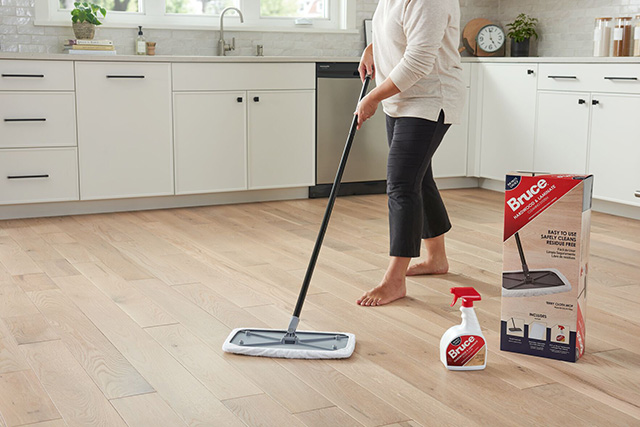
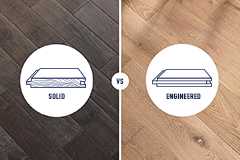 Solid vs Engineered Hardwood Flooring
Solid vs Engineered Hardwood Flooring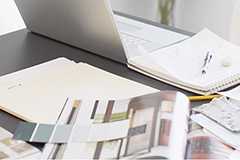 Guide To Choosing a Hardwood Floor
Guide To Choosing a Hardwood Floor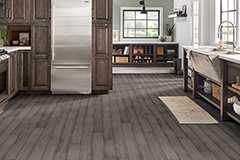 Hardwood Flooring Room Inspiration Guide
Hardwood Flooring Room Inspiration Guide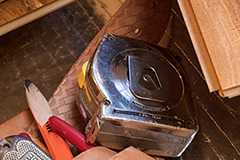 10 Things to Know About Hardwood Floor Installation
10 Things to Know About Hardwood Floor Installation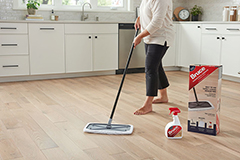 How To Clean and Protect Hardwood Flooring
How To Clean and Protect Hardwood Flooring